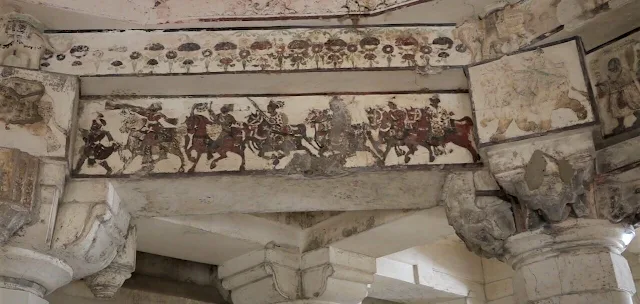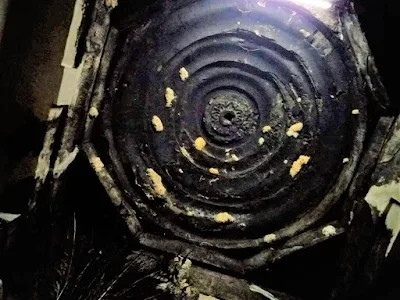Gori Jain Temple: Uncovering Ancient Heritage of Tharparkar
Gori or Godi Jain Temple, also known as Godiji Godecha Parshvanath Jain Temple, is one of the oldest Jain temples located in Nagarparkar, district Tharparkar. Built in 1375-1376 A.D., this stunning temple is dedicated to Lord Parshwanath, the 23rd Tirthankara in Jainism.
Other Names of Temple:
- Godiji Jain Temple
- Godi Jain Temple
- Godecha Parshvanath Jain Temple
- Godiji Parshawanath Temple
- Godiji Shwetambar Jain Derasar
Location of Gori temple
The historic site of Gori Temple is situated on a way between Islamkot and Nagarparkar. It lies approximately 26 kilometers (14 miles) northwest of the village of Virawah and about 44 kilometers (27 miles) from Nagarparkar. Which means, travelers traveling from Mithi to Nagarparkar, via Islamkot, will find the temple about 90 kilometers into their journey. This makes Gori Temple a convenient and captivating stopover for those exploring the scenic Tharparkar region.
GPS Coordinates of Location: 24.63834, 70.61774
The area of Jain temple was popular and famous by the name Goripur (or Godipur), which had been a religious and busy town for several centuries. In the past, it had been pilgrimage and religious site for Jain people around the world till the partition of India in 1947.
 |
| Top Eagle-view of Godiji Jain Temple of Nagarparkar (Image taken from Google Maps) |
Construction and Architecture of Godi Jain Temple
Godiji temple having dimensions of 125 ft by 50 ft and facing north direction was built with marble stones in 14th century. The roof of this temple is adorned with 52 cupolas (lower domes), 2 mandapas in center and a large Shikhara. The architecture and design of the temple is based on marvelous and classical Nagara or Gujarati style temple architecture during the medieval period of India. Its architectural design or pattern somewhat resembles with Vimal Vasahi Jain temple (located at Mount Abu, Rajasthan, India) and Hatheesing Jain Temple (located at Ahmedabad, Gujrat India).
 |
| Hatheesing Jain Temple of Ahmedabad (Gujarat, India) |
According to manuscripts and Jain scholars [1][2], the original white-marble image of 1.5 feet height was installed by Seth Godidas of Jhinjhuvad (Rajasthan, India) and declared sacred by Jain scholar Acharya Hemachandra at Patan (Rajasthan, India) in 1171 A.D. That image was later brought to Patan and buried underground as safekeeping during wars against enemies or invaders.
As per old texts [3], in 1375-1376 A.D a Jain merchant Megha Sa Oswal of Pari-Nagar (now ruined site near Nagarparkar, district Tharparkar, Pakistan) went to Patan for business purpose. There he was informed in a dream by a spirit that he should try to secure the image buried beneath the house of local Muslim of Patan. Merchant Megha Sa Oswal succeeded in acquiring that precious image by paying 500 pieces (takka) or 125 drammas and brought in Pari-Nagar which was formally re-consecrated by Jain Scholar and author, Acharaya Merutanga [4] of Achal Gachchha (Gujarat, India). Then, same spirit again appeared in dream and instructed Megha Sa to procure two calves with a cart made of Margosa (Neem tree), take that image on it and move without looking behind. On reaching the site where temple is now standing, that cart broke down and Megha Sa, being tired fell asleep and then spirit again appeared in his dream and further instructed to build a temple with marble stones and water lying underground of that site.
Following the instructions of a spirit, Megha Sa built a temple, which was constructed with supervision of Architect from Sirohi, and temple became famous with name 'Godiji Parshawanath Temple'. And also a new town with name Goripur (pronounced in Godipur in Gujrati language) was settled around the temple. Some accounts by researchers mention that the central tower or Shikhara was completed by Megha's son, Mahio who was awarded the title of 'Sanghpati' by the people of this area.
Adjacent to this jain temple, people can find a underground secret tunnel, which as per local people was once used to travel from this side to some other distant part of Karoonjhar hills.
 |
| Side view of Gori Jain Temple |
 |
| Top side view of Gori Jain Temple |
| Shikhara section of Gori Jain temple which is now in ruined condition |
 |
| Front-Top view of Gori Jain Temple |
 |
| Paintings (frescos) on a roof of big Mandapa of Gori Temple |
 |
| Interior top bottom view of largest mandapa of Gori Temple |
 |
| Top view of Paintings in Gori Jain Temple |
 |
| Paintings (frescos) on walls depicting royal rides of camels and elephants |
 |
| Inside view of Gori temple |
 |
| Outside Wall of Gori temple built of stones |
 |
| Shikahara of Gori Jain Temple which is now in ruined state. |
 |
| Statues carved on the wall of stones of Gori temple |
 |
| Roof top view of a dome section of Gori temple |
 |
| Underground secret tunnel besides the Gori temple |
Missing of diamond-studded Idol of Godecha or Parshwanath
In the 1716, the image or idol of the temple was shifted from temple to Bakasir Fort (Bakar fort) by Sutojee Sodha Rajput (Parmar dynasty), a local ruler/chieftain of that time. That image was used to be safeguarded in secret location and then displayed during the time of celebrations or rituals of Jain religions. As per writings in book [5] of author Captain Stainley Napiers Raikes who visited the site of temple and met with local Jains and consulted with scholar Yati Guruji Kuntvuja Ji in 1854, thousands of Jogis, Jain monks and ordinary people had assembled for the fairs held in year 1764, 1788, 1796, 1810, 1822 & 1824 for the exhibition of image of Godecha. After Sutojee Sodha Rajput, new Sodha chieftain Poonjaji Sodha had produced/exhibited that image of Godi (Godecha or Parshwanath) during different fairs on offerings from Jains for which he used as main source of his revenues [6].
But now, the temple is empty with no any image or idols there, because the image got missing due to death of ruler Poonjaji Sodha Rajput in 1832 during captivity by Ex-Ameers of Talpur Dynasty. Poonjaji Sodha Rajput was only and last custodian of that image and knew the secret location of image [5].
Thus, the secret of the hiding place of the diamond-studded idol of Gorecha or Prasanath also went up like the smoke of Poonjajee’s funeral pyre. Despite all their efforts, the Talpurs could not find where the priceless statue was buried and finally they eventually gave up. Nowdays, the memory of the fabulous statue is now dimmed and passed from local people minds away.
Damage of Temple Structure
The Gori Jain temple was heavily damaged in the battle between local Sodha rulers and Colonel Tyrwhitt 1859 during the British empire [7]. As the temples in that area were used to hide as shelter against enemies. After then, that temple was repaired by local community of Jains at that time and used it for their religious purposes.
Condition of Gori Jain Temple after Post-Partition of India
During the partition time of India, community of Jains living in that area had migrated to India leaving behind all temples of Nagarparkar including Gori temple in condition of ruined and abandoned sites. However, the local district and provincial government and government of Pakistan has been taking steps to safeguard and restore all the structures of Jain temples in order to promote tourism by highlighting marvelous architectural values and reflections of Jainism religion in Pakistan [8].
Recently, government of Pakistan has taken steps to include historic sites of Nagarparkar landscape in the tentative list of UNESCO, World Heritage Site status [9].
References:
[1] Bhanvarlal Nahta, Shri Gaudi Parchvanath Tirth, Muni Jinavijaya Abhinandan Granth, Ed. Dalsukh Malvania, Jinavijayaji Samman Samiti, Jaipur, 1971, p. 263-275
[2] Jain Paramparano Itihas, Munishi Darshanvijaya, Jnanavijaya, Nyayavijaya, Charitra Smarak Granthamala, Ahmedabad, 1960, p. 739-743
[3] Burgess, J., & Cousens, H. (1897). Revised Lists of Antiquarian Remains in the Bombay Presidency: And the Native States of Baroda, Palanpur, Radhanpur, Kathiawad, Kachh, Kolhapur, and the Southern Maratha Minor States. Printed at the Government central Press [page: 222].
[4] Wikipedia contributors. (2021, February 18). Merutunga. In Wikipedia, The Free Encyclopedia. Retrieved 05:52, November 29, 2021, from https://en.wikipedia.org/w/index.php?title=Merutunga&oldid=1007453358
[5] Stanley Napier Raikes, Memoir on the Thurr and Parkur districts of Sind, Education Society's Press, Byculla, 1859. p. 83, Appendix B
[6] Alex. Burnes. “Papers Descriptive of the Countries on the North-West Frontier of India:-The Thurr, or Desert; Joodpoor and Jaysulmeer.” The Journal of the Royal Geographical Society of London 4 (1834): 88–129. https://doi.org/10.2307/1797686.
[7] Gori Temple Pakistan. (2013, July 28). Encyclopedia, . Retrieved 08:11, November 29, 2021 from http://en.encyclopediaofjainism.com/index.php?title=Gori_Temple_Pakistan&oldid=2359.
[8] Conservation, preservation and restoration of Gori Jo Mandir (Temple), Directorate General of Antiquities, Governemnt of Sindh, Retrieved October 28th, 2021 from https://antiquities.sindhculture.gov.pk/index.php/activities/conservation-work/conservation-preservation-and-restoration-of-gori-jo-mandir-temple
[9] Nagarparkar Cultural Landscapes, Tentative Lists, World Hertilage Center, UNESCO. Retrieved October 28, 2021 from https://whc.unesco.org/en/tentativelists/6111/


Comments
Post a Comment